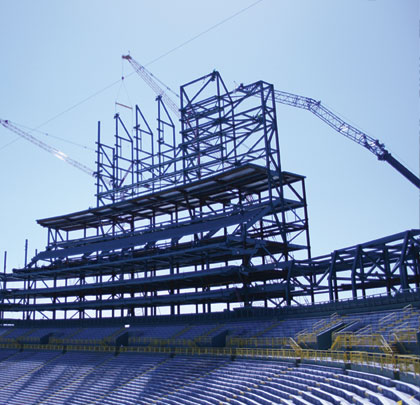Induction heating technology in structural steel welding was among the latest construction industry advancements used in the high-profile expansion at Lambeau Field, home of the NFL’s Green Bay Packers.
The expansion project added about 6,600 new seats, a new viewing deck, enhanced entryways and stadium access, and two giant video boards. It also had to be done on a strict time schedule, with much of the work completed during winter in northern Wisconsin.
The project construction manager, Miron Construction Co., Inc., of Neenah, Wisconsin, partnered with another Wisconsin company, Miller Electric Mfg. Co., to bring the latest in welding technologies for the construction industry to the Lambeau Field project. The partnership between Miller and Miron included the addition of induction heating, a more efficient technology that saves time on the preheat setup and allows welding without stops to bring the material back up to temperature. Induction heat also provides more uniform heating throughout the weld area.
Induction heating provided a faster and easier process for the expansion undertaking. And because induction heating creates heat without an exposed heating element, it’s a safer process for operators.
In this article, we’ll specifically look at the use of induction heating in structural steel welding applications. Miron Construction used the ProHeat™ 35 induction heating system from Miller throughout the project as a faster and more efficient way of bringing the steel columns to temperature—and keeping them there—than using a propane-fueled torch.
The overall benefits of induction heating compared to heating with a torch include faster time-to-temperature; consistent heating throughout the entire part; easier to apply; lower consumable costs by reducing or eliminating gas expenses; and reduction of total weld cycle times, thereby improving productivity.
STEEL REINFORCEMENTS
Miron Construction began work on reinforcing existing steel structures at Lambeau Field in September 2011. Work ramped up in January 2012, as the regular season ended and crews were able to remove the old scoreboards. The North End Zone construction revolved around the addition of a massive elevator shaft for six new elevators, the new party deck that sits on top the stadium roof, and the new Mitsubishi Diamond Vision Video Board.
The work in the South End Zone is even more extensive: to support the structures for the new video board and the new seating, an additional bay was added to the existing bowl and seven new levels were built on top of the existing three levels. This is where the majority of the added seating will be, as well as indoor shops and concessions. It also required major reinforcement of the existing steel columns.
This reinforcement included extending base plates and adding plating and bar stock to the existing columns. Large 3-inch plate steel caps were also added to the very top of each column to act as a base for the new steel structure to be built on top of it. In order to do this and meet structural requirements, the new plate steel as well as the existing column (16 inches by 16 inches) had to be brought to and maintained at a temperature of 150 degrees F during the welding process. Preheating helps prevent rapid cooling of the weld metal, relieves stresses, and drives out hydrogen, which can lead to cracking and embrittlement. This is historically done in the construction industry using propane-fueled torches (aka rosebuds, weed burners, etc.). This method of heating, however, poses problems, including:
- Inconsistent heating throughout the steel; the large size of the columns combined with the cold weather when much of this work was performed makes it difficult to evenly maintain temperatures.
- Purchasing, storage, and handling of volatile heating fuels.
- Safety dangers associated with using a high-temperature open flame.
- Constant starts and stops during the welding process to bring the column back up to temperature using a heating torch.
UNIFORM HEATING
With the ProHeat™ 35 induction heating system, Miron Construction was able to bring each column or cap plate to temperature, leave the induction heating coils in place, and make the complete weld without stopping (except to switch out Stick electrodes). This saves a substantial amount of time and provides uniform heating throughout the weld area.
“The induction heating system has actually been great for plating the columns and welding on the side,” explains Jake Wirkuty, an ironworker with Miron Construction Co., Inc. “It saves a lot of time on the preheat setup. Instead of welding 3 inches, preheating, and then welding 3 inches, it’s been excellent just to slap the coil on the side of the column. We have an 8-foot setup which, with two guys, one on each side of the column welding and keeping that temp up, it saves probably half the time or more of preheating.”
While quality and safety are paramount, productivity is also an obvious factor. With this being a high-profile project with strict deadlines to meet, any process that increases productivity is going to be given serious consideration. As Wirkuty previously stated, induction heating allows the welders to bring the part to temperature in less than half the time of heating with a torch, and eliminates the need to stop welding to reheat the part—reducing total welding cycle times. When factoring in all of the benefits, Wirkuty knows it’s a viable and much more efficient technology for this application that will help lower total weld cycle costs. ■
For More Information:
Steve Latvis, induction heating applications specialist, and Dan Niemela, district manager, are with Miller Electric Mfg. Co. For more information, visit www.millerwelds.com.
_________________________________________________________________________
Modern Contractor Solutions, March 2014
Did you enjoy this article?
Subscribe to the FREE Digital Edition of Modern Contractor Solutions magazine.



